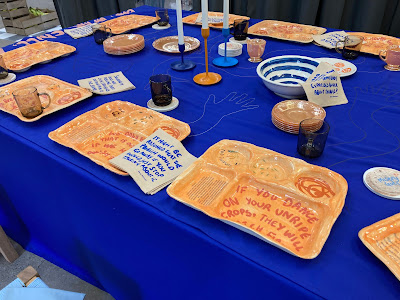- Get link
- X
- Other Apps
- Get link
- X
- Other Apps
What happens after you finish a big project or time-consuming piece of work? I remember well how finishing my Fine Art degree as a mature student hit me. It was like falling off a ledge into the unknown and I struggled to do anything much that summer. I had pushed myself so hard, while still needing to look after my family and other commitments, that I crashed for a while afterwards.
 |
| Still from 'Longings & Belongings' animation, 2022 |
Finishing off my year-long research and development project, Grow Your Own Artist (supported by Arts Council England through their Developing Your Creative Practice DYCP funding stream) has been a different experience. The pressure was highest at the start of the project, as the funding application is a tough one and getting started was daunting, but I managed to follow my Project Plan, checking in with it regularly and adjusting it as the project progressed. In fact, the plan was a very useful tool that I will be taking forward into other artistic projects.
Having funding support has changed things for me in a big way, by giving me much needed time and resources to spend on my art practice. The conversations that I’ve had with artists and curators throughout the project have provided a huge amount of support and encouragement, which has seen my confidence bloom. Speaking to other artists I know, we all seem to carry at least a little ‘imposter syndrome’, even amongst those who appear quite successful. There’s always a bit of a battle about whether what we make is ‘good’ enough. Grow Your Own Artist made me feel that people take my practice seriously and that there’s no need to spend time worrying about this: I can rely on my internal quality control to let me know if something I make is successful or not (see my previous post about drawing).
The way that I feel now is that a source of pressure that was stifling my work has been released and I have rediscovered the joy of experimentation, confidence to apply for different kinds of opportunity and a way to make applications less of a chore. Applications for opportunities are part of many artists’ work and they can be very time-consuming, with a slim chance of being selected, sometimes from hundreds of competing applications. I have applied for some things in the last couple of months without tying myself in so many knots, aiming to tell the story of the work in a more engaging way.
 |
| Sketchbook planning for an application |
The key change I’ve made has been to sit down away from the computer, writing and drawing ideas out before attempting to fill in the application itself, and this has made my applications feel more creative and allowed them to have a better flow. I have also abandoned an application when it didn’t come together in a meaningful way, as I realised that this was not the right opportunity for me. A conversation with artist and researcher Lucy Wright (via artist support organisation Axis) helped me to find an alternative way of approaching opportunities. Lucy suggested spending time putting ideas down and writing around a theme before attempting the application itself, and this is working well for me.
I have been successful in two applications this summer, a commission for the Centre for Cultural Value to make an animation that responds to a report into artists’ social practice and I’ve just had an animation accepted for an online exhibition for Mykolaiv ArtWeek MEMORY, Ukraine – my first international exhibition.
The other thing that’s been really important to me in keeping up the momentum from Grow Your Own Artist is continuing to talk to other artists and take part in events. I participated in Summer Show at Birmingham’s Eastside Projects this August, showing a film that I made in 2021 and this was a great place to chat to other artists and see new work (the exhibition looked excellent).
 |
| khao, peyo, aish karo, but don’t hurt anyone’s heart by Roo Dhissou at Eastside Projects |
I am part of a group of artists in Hereford, examining the theme of Humanity, and we just did a DIY event where we created our own art walk for ourselves, christened the Trial Trail. It was a brilliant way of talking about our work together, showing something experimental to a group of peers, with no external pressure to create specific outcomes. We shared a picnic afterwards too, so it was very sociable.
 |
| An intervention next to the River Wye by Viv Barraclough |
I will be showing an animation about how our memories are connected to the objects we keep (titled Longings & Belongings) in an exhibition about grief called At a Loss, opening this October in the Art Central Gallery, in Barry, South Wales. I am looking forward to meeting the artists involved at the launch event, so that we can discuss the ideas we’re working with.
Comments
Post a Comment